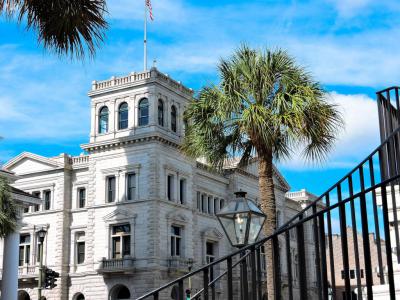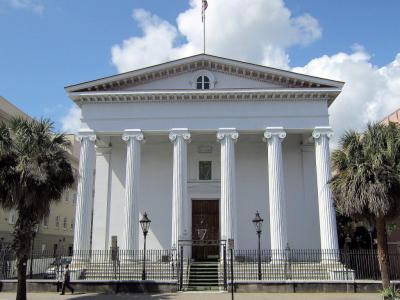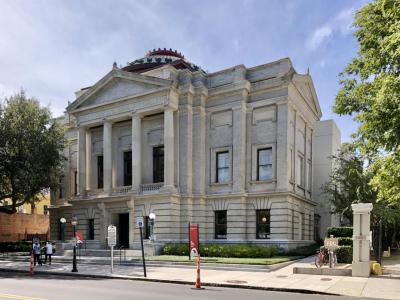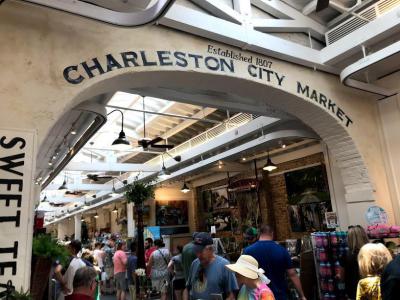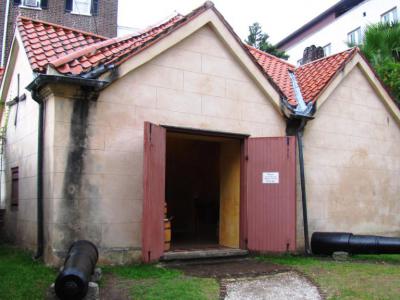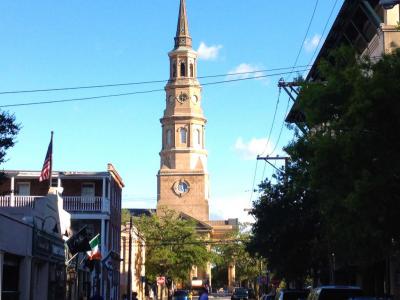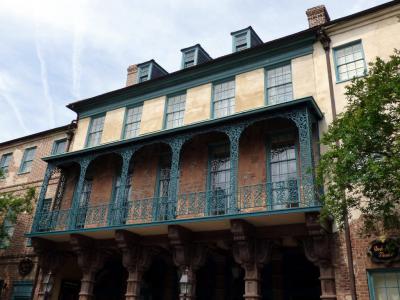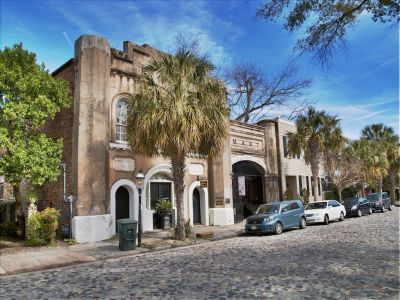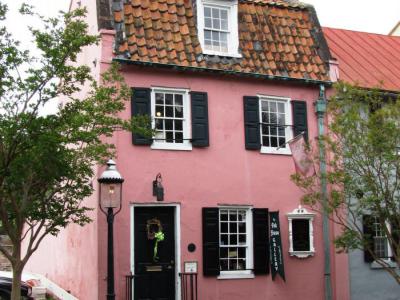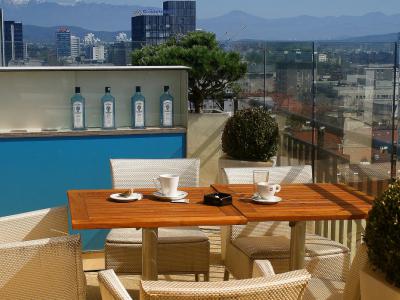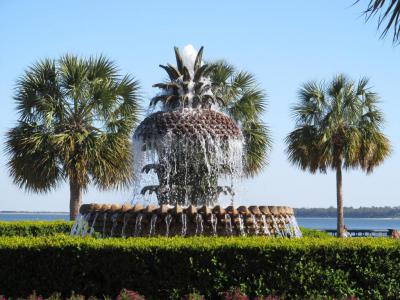French Quarter Walking Tour (Self Guided), Charleston
A historic district in downtown Charleston, The French Quarter is named so for the high concentration of French merchants that once lived in the area and left their mark on it. The name was coined in 1973, when preservation efforts began for warehouse buildings on the Lodge Alley block. That same year the district was added to the National Register of Historic Places.
The busy neighbourhood forms part of Charleston’s original walled city, and is bounded by the Cooper River on the east, Broad Street on the south, Meeting Street on the west, and Market Street on the north. It was settled as part of the original Grande Modell of Charles Towne in 1680.
Charleston's French Quarter is home to many fine historic buildings, such as the Pink House Tavern, built around 1712, the Dock Street Theatre, arguably the first site of theatrical productions in the United States, and St. Philip's Episcopal Church, the first congregation in Charleston, whose current structure dates to 1835. St. Philip's graveyard is the final resting place of Edward Rutledge, the youngest signer of the Declaration of Independence, and U.S. Senator and Vice President John C. Calhoun.
Also in the French Quarter you will find the 19th-century City Market, selling clothing, crafts, and artwork, with the Confederate Museum in the old Market Hall. Another popular location frequented by locals and visitors alike is Waterfront Park on the Cooper River.
For a more detailed acquaintance with the most important attractions in Charleston's historic French Quarter, follow this self-guided walking tour.
The busy neighbourhood forms part of Charleston’s original walled city, and is bounded by the Cooper River on the east, Broad Street on the south, Meeting Street on the west, and Market Street on the north. It was settled as part of the original Grande Modell of Charles Towne in 1680.
Charleston's French Quarter is home to many fine historic buildings, such as the Pink House Tavern, built around 1712, the Dock Street Theatre, arguably the first site of theatrical productions in the United States, and St. Philip's Episcopal Church, the first congregation in Charleston, whose current structure dates to 1835. St. Philip's graveyard is the final resting place of Edward Rutledge, the youngest signer of the Declaration of Independence, and U.S. Senator and Vice President John C. Calhoun.
Also in the French Quarter you will find the 19th-century City Market, selling clothing, crafts, and artwork, with the Confederate Museum in the old Market Hall. Another popular location frequented by locals and visitors alike is Waterfront Park on the Cooper River.
For a more detailed acquaintance with the most important attractions in Charleston's historic French Quarter, follow this self-guided walking tour.
How it works: Download the app "GPSmyCity: Walks in 1K+ Cities" from Apple App Store or Google Play Store to your mobile phone or tablet. The app turns your mobile device into a personal tour guide and its built-in GPS navigation functions guide you from one tour stop to next. The app works offline, so no data plan is needed when traveling abroad.
French Quarter Walking Tour Map
Guide Name: French Quarter Walking Tour
Guide Location: USA » Charleston (See other walking tours in Charleston)
Guide Type: Self-guided Walking Tour (Sightseeing)
# of Attractions: 11
Tour Duration: 1 Hour(s)
Travel Distance: 1.7 Km or 1.1 Miles
Author: alice
Sight(s) Featured in This Guide:
Guide Location: USA » Charleston (See other walking tours in Charleston)
Guide Type: Self-guided Walking Tour (Sightseeing)
# of Attractions: 11
Tour Duration: 1 Hour(s)
Travel Distance: 1.7 Km or 1.1 Miles
Author: alice
Sight(s) Featured in This Guide:
- Charleston County Courthouse
- Hibernian Hall
- Gibbes Museum of Art
- Historic City Market
- Powder Magazine
- St. Philip's Church
- Dock Street Theatre
- Old Slave Mart
- Pink House
- The Rooftop at The Vendue
- Joe Riley Waterfront Park
1) Charleston County Courthouse
The design of this Neoclassical building in Charleston was inspired by Leinster House in Dublin, the current seat of the Irish Parliament, architected by James Hoban. The Courthouse itself later served as a model for Hoban's other, most famous creation – the U.S. White House.
George Washington was so impressed with Hoban's previous work that he summoned the architect to Philadelphia in June 1792. The following month, Hoban was declared the winner of the design competition for the presidential mansion in D.C.
An operational courthouse and a museum wrapped into one, this building makes for a nice, albeit short, historical experience. The free self-guided tour is made easy with tidbits of information given by the security guards.
Indeed, history echoes throughout this property hung with original life-size paintings portraying prominent figures like George Washington and Andrew Jackson. While the second-floor porch (from where the Declaration of Independence was read out to Charlestonians) has been unfortunately lost to time, the onsite law library remains intact complete with its wood panels, brass railings, and an impressive collection of leather-bound books in glass cases. An absolute must-see for history lovers!
Tip:
Take a moment to explore the impeccably maintained retro bathroom during your visit.
George Washington was so impressed with Hoban's previous work that he summoned the architect to Philadelphia in June 1792. The following month, Hoban was declared the winner of the design competition for the presidential mansion in D.C.
An operational courthouse and a museum wrapped into one, this building makes for a nice, albeit short, historical experience. The free self-guided tour is made easy with tidbits of information given by the security guards.
Indeed, history echoes throughout this property hung with original life-size paintings portraying prominent figures like George Washington and Andrew Jackson. While the second-floor porch (from where the Declaration of Independence was read out to Charlestonians) has been unfortunately lost to time, the onsite law library remains intact complete with its wood panels, brass railings, and an impressive collection of leather-bound books in glass cases. An absolute must-see for history lovers!
Tip:
Take a moment to explore the impeccably maintained retro bathroom during your visit.
2) Hibernian Hall
Despite the challenges posed by the Civil War, multiple fires, and the devastating earthquake of 1886, many of Charleston's historic buildings have survived. Among them is the Hibernian Hall, a grand piece of Greek Revival architecture with imposing white columns, designated as a National Historic Landmark in 1973. It was originally designed for the Irish Hibernian Society, known for organizing the first Saint Patrick's Day parades in the United States.
Most important, however, is the hall's historic association with the 1860 Charleston Convention, in which the Democratic Party, divided by opinions on slavery, failed to select a presidential nominee and thus ensured victory for the anti-slavery Republican candidate, Abraham Lincoln, in the presidential election that year.
Having served as a venue for countless debutante balls hosted by the Hibernian Society, today the building is often used for wedding receptions. Its three-story rotunda, complete with dual staircases leading to the ballroom, provides an elegant setting for bridal parties to make a grand entrance, often accompanied by the stirring sounds of a bagpiper - a cherished Hibernian tradition.
Most important, however, is the hall's historic association with the 1860 Charleston Convention, in which the Democratic Party, divided by opinions on slavery, failed to select a presidential nominee and thus ensured victory for the anti-slavery Republican candidate, Abraham Lincoln, in the presidential election that year.
Having served as a venue for countless debutante balls hosted by the Hibernian Society, today the building is often used for wedding receptions. Its three-story rotunda, complete with dual staircases leading to the ballroom, provides an elegant setting for bridal parties to make a grand entrance, often accompanied by the stirring sounds of a bagpiper - a cherished Hibernian tradition.
3) Gibbes Museum of Art
After moving to its present Beaux-Arts building (boasting an impressive stained glass cupola) in 1905, the Gibbes Museum of Art has earned a reputation as one of the finest of its kind. Its premier collection contains over 10,000 art pieces, principally American works, spanning from colonial to contemporary periods, many of which are closely associated with Charleston and the South.
Following renovation, the museum's ground floor houses an education center, cafe, and a store, while its rear reception area opens up to a garden that is part of Charleston's historic Gateway Walk, an initiative founded by the Garden Club. The entire floor is open to the public free of charge, serving as a community gathering space.
The recently expanded and renovated galleries on the second and third floors showcase over 600 artworks from the permanent collections, including pieces by various artists from Charleston such as Henrietta Johnston, Mary Roberts, Charles Fraser, William Melton Halsey, Ned I.R. Jennings, and Jeremiah Theus.
Of particular interest is the collection of more than 300 miniature portraits displayed in cases and open-storage cabinets to allow an up-close view. Other collections include paintings, prints, sketches, photographs, sculptures, ceramics, furnishings, and works by African-American artists, many of whom are natives of Charleston and South Carolina.
Why You Should Visit:
To enjoy a charming 'stroll' through art and gain new insights, while exploring unexpected and unfamiliar artworks. Garden concerts in the spring and fall are particularly fun, and the "Gibbes on the Street" event held in April/May is unmissable.
Tip:
Catch one of the many rotating exhibitions here whenever you're in town – you'll be in for a treat.
Following renovation, the museum's ground floor houses an education center, cafe, and a store, while its rear reception area opens up to a garden that is part of Charleston's historic Gateway Walk, an initiative founded by the Garden Club. The entire floor is open to the public free of charge, serving as a community gathering space.
The recently expanded and renovated galleries on the second and third floors showcase over 600 artworks from the permanent collections, including pieces by various artists from Charleston such as Henrietta Johnston, Mary Roberts, Charles Fraser, William Melton Halsey, Ned I.R. Jennings, and Jeremiah Theus.
Of particular interest is the collection of more than 300 miniature portraits displayed in cases and open-storage cabinets to allow an up-close view. Other collections include paintings, prints, sketches, photographs, sculptures, ceramics, furnishings, and works by African-American artists, many of whom are natives of Charleston and South Carolina.
Why You Should Visit:
To enjoy a charming 'stroll' through art and gain new insights, while exploring unexpected and unfamiliar artworks. Garden concerts in the spring and fall are particularly fun, and the "Gibbes on the Street" event held in April/May is unmissable.
Tip:
Catch one of the many rotating exhibitions here whenever you're in town – you'll be in for a treat.
4) Historic City Market (must see)
A visit to Charleston would be incomplete without exploring the Historic City Market. Established in the 1790s, it spans four city blocks, covering a vast 33-acre area, starting from the temple-like Market Hall, which now houses the Confederate Museum.
Back in its prime during the early 20th century, the market provided a livelihood for thousands of African-American entrepreneurs and vendors. Today, it remains operational with dozens of vendors offering a wide range of souvenirs and goods, including clothing, jewelry, chocolates, artwork, Gullah sweetgrass baskets, and regional keepsakes.
Places of note include Callie's Hot Little Biscuit, Carolina Rice, Carolina Tea, and other eateries within the market. The surrounding area also has numerous shops, ice cream parlors, and restaurants, making it worthwhile to plan for several hours of exploration and enjoyment.
An excellent option for a rainy day visit (since it offers shelter), the market allows you to browse comfortably, stay dry, and hopefully discover some great deals. While credit cards are accepted, it's advisable to carry some cash as you might receive discounts for cash payments. Additionally, from April through December, the Night Market hosts local artists and food vendors on weekends.
The entire market complex was declared a National Historic Landmark and added to the National Register of Historic Places in 1973.
Back in its prime during the early 20th century, the market provided a livelihood for thousands of African-American entrepreneurs and vendors. Today, it remains operational with dozens of vendors offering a wide range of souvenirs and goods, including clothing, jewelry, chocolates, artwork, Gullah sweetgrass baskets, and regional keepsakes.
Places of note include Callie's Hot Little Biscuit, Carolina Rice, Carolina Tea, and other eateries within the market. The surrounding area also has numerous shops, ice cream parlors, and restaurants, making it worthwhile to plan for several hours of exploration and enjoyment.
An excellent option for a rainy day visit (since it offers shelter), the market allows you to browse comfortably, stay dry, and hopefully discover some great deals. While credit cards are accepted, it's advisable to carry some cash as you might receive discounts for cash payments. Additionally, from April through December, the Night Market hosts local artists and food vendors on weekends.
The entire market complex was declared a National Historic Landmark and added to the National Register of Historic Places in 1973.
5) Powder Magazine
Just a few blocks away from the bustling market area in Charleston stands the oldest public building in both Carolinas, the Powder Magazine. Surprisingly, this site is relatively unknown to tourists and even some locals too, possibly because it doesn't have the same prominence as other local landmarks. However, this utilitarian structure predates Charleston's legendary aesthetic charm, reflecting a time when the newly established English settlement prioritized self-defense and basic survival.
In the early 18th century, Charles Towne (as it was known back then) still faced threats and was fortified against possible assaults from Spanish forces, hostile Indians, unruly groups of pirates, and occasional French attacks. In response to the colony's governor's request for additional cannons and a secure supply of gunpowder to "make Carolina impregnable", the British Crown approved and funded the construction of the Powder Magazine in 1703. Its thick walls were designed to contain an explosion should the gunpowder stored inside ever detonate.
The Powder Magazine was overseen by a newly appointed official – powder receiver – responsible for collecting a gunpowder tax levied on all merchant ships entering the harbor. The building had served its original purpose for many years before, eventually, it was deemed unnecessary and sold into private hands. The unique structure, with multiple gables and a tile roof, was almost forgotten by historians until the early 1900s when it was purchased by The National Society of The Colonial Dames of America in the State of South Carolina.
Maintained and operated as a small museum until 1991, the property suffered from water damage, roof deterioration, and the passage of time. The Historic Charleston Foundation, which had leased the building from The Colonial Dames since 1993, undertook its extensive restoration. In the summer of 1997, the Powder Magazine reopened to the public as a new interactive exhibit harking back to Charleston's early years when it was still a relatively rudimentary colonial outpost of the British Empire. Next door to it, the privately owned Trott's Cottage, Charleston's first brick dwelling constructed in 1709, offers further historical context.
Tip:
They have a cool gift shop on the premises specially themed for pirate lovers – check it out.
In the early 18th century, Charles Towne (as it was known back then) still faced threats and was fortified against possible assaults from Spanish forces, hostile Indians, unruly groups of pirates, and occasional French attacks. In response to the colony's governor's request for additional cannons and a secure supply of gunpowder to "make Carolina impregnable", the British Crown approved and funded the construction of the Powder Magazine in 1703. Its thick walls were designed to contain an explosion should the gunpowder stored inside ever detonate.
The Powder Magazine was overseen by a newly appointed official – powder receiver – responsible for collecting a gunpowder tax levied on all merchant ships entering the harbor. The building had served its original purpose for many years before, eventually, it was deemed unnecessary and sold into private hands. The unique structure, with multiple gables and a tile roof, was almost forgotten by historians until the early 1900s when it was purchased by The National Society of The Colonial Dames of America in the State of South Carolina.
Maintained and operated as a small museum until 1991, the property suffered from water damage, roof deterioration, and the passage of time. The Historic Charleston Foundation, which had leased the building from The Colonial Dames since 1993, undertook its extensive restoration. In the summer of 1997, the Powder Magazine reopened to the public as a new interactive exhibit harking back to Charleston's early years when it was still a relatively rudimentary colonial outpost of the British Empire. Next door to it, the privately owned Trott's Cottage, Charleston's first brick dwelling constructed in 1709, offers further historical context.
Tip:
They have a cool gift shop on the premises specially themed for pirate lovers – check it out.
6) St. Philip's Church
The Anglican church of Saint Philip is the second (after Saint Michael's) most prominent church in Charleston, erected in the 1830s. Its congregation, however, is the oldest in town, tracing its roots back to the colony's fledgling years. Located in the heart of the French Quarter and described as "a building of the highest quality and sophistication,” this sanctuary has two historic graveyards. The imposing tower, designed in the Wren-Gibbs tradition, justifies the church's National Historic Landmark status.
Throughout the 18th century, this was the place of worship for notable figures like Charles Pinckney, a key author and signer of the U.S. Constitution; his grave is found in the church's cemetery. Also, there is the grave of Christopher Gadsden, a founding father who designed the famous flag featuring a coiled snake and the words "Don't tread on me".
Moving into the 19th century, Saint Philip's became the spiritual home of senator, vice-president, and Secretary of State, John C. Calhoun, who was instrumental in advancing the theory of states' rights. After he died in 1850, Calhoun was initially interred in the former "stranger's churchyard" behind the church; however, with the onset of the Civil War, his remains were relocated to the portion of the cemetery across the street. Eventually, the state of South Carolina erected a huge monument at his gravesite extolling his numerous achievements.
Why You Should Visit:
One of South Carolina's most photographed buildings!
The surrounding well-preserved graveyard is a fascinating historical site filled with remarkable gravestones.
Tip:
Stop across the street at the historically-affiliated French Huguenot Church; both buildings have amazing histories and architecture!
Throughout the 18th century, this was the place of worship for notable figures like Charles Pinckney, a key author and signer of the U.S. Constitution; his grave is found in the church's cemetery. Also, there is the grave of Christopher Gadsden, a founding father who designed the famous flag featuring a coiled snake and the words "Don't tread on me".
Moving into the 19th century, Saint Philip's became the spiritual home of senator, vice-president, and Secretary of State, John C. Calhoun, who was instrumental in advancing the theory of states' rights. After he died in 1850, Calhoun was initially interred in the former "stranger's churchyard" behind the church; however, with the onset of the Civil War, his remains were relocated to the portion of the cemetery across the street. Eventually, the state of South Carolina erected a huge monument at his gravesite extolling his numerous achievements.
Why You Should Visit:
One of South Carolina's most photographed buildings!
The surrounding well-preserved graveyard is a fascinating historical site filled with remarkable gravestones.
Tip:
Stop across the street at the historically-affiliated French Huguenot Church; both buildings have amazing histories and architecture!
7) Dock Street Theatre
The very first theatrical production in North America took place in Charleston in January 1735, when a traveling troupe performed Thomas Otway's "The Orphan" in the city's courtroom. The performance's success led to the construction of the Dock Street Theater.
In 2010, after a three-year restoration costing $19 million, the theater reopened for the third time in its history. Overlooking the Huguenot Church across the street and almost in the shadow of Saint Philip's Church, the venue exudes an artsy feel with its French influences.
Aside from hosting an active and highly regarded annual season by its resident company, the Dock Street Theatre has given stage to numerous events over the decades including the Spoleto Festival. The wonderfully restored interior is worth checking out whether or not you plan to see a show; simply step into the lobby and ask to have a look around.
Why You Should Visit:
Merely walking around the area is worth the trip (pure Charleston!). The theater itself is just charming, snug (seating about 500), warm, and overall remarkably comfortable, with acoustics that are easy on the ears. Green velvet curtains and exquisite woodwork give it a New Orleans French Quarter feel. Also, it's a great bathroom break spot if you're exploring the French Quarter on foot.
Box Office Hours:
Mon-Fri: 1–5 pm; Sat 1:00 pm–curtain, only on performance days
Box Office will open 1 hour before each performance
In 2010, after a three-year restoration costing $19 million, the theater reopened for the third time in its history. Overlooking the Huguenot Church across the street and almost in the shadow of Saint Philip's Church, the venue exudes an artsy feel with its French influences.
Aside from hosting an active and highly regarded annual season by its resident company, the Dock Street Theatre has given stage to numerous events over the decades including the Spoleto Festival. The wonderfully restored interior is worth checking out whether or not you plan to see a show; simply step into the lobby and ask to have a look around.
Why You Should Visit:
Merely walking around the area is worth the trip (pure Charleston!). The theater itself is just charming, snug (seating about 500), warm, and overall remarkably comfortable, with acoustics that are easy on the ears. Green velvet curtains and exquisite woodwork give it a New Orleans French Quarter feel. Also, it's a great bathroom break spot if you're exploring the French Quarter on foot.
Box Office Hours:
Mon-Fri: 1–5 pm; Sat 1:00 pm–curtain, only on performance days
Box Office will open 1 hour before each performance
8) Old Slave Mart (must see)
Constructed in 1859, this building, designed in the Gothic Revival and Romanesque styles with a stuccoed façade, originally formed part of the slave market known as Ryan's Mart. Named after city alderman and slave profiteer, Thomas Ryan, it occupied a large enclosed area between Chalmers and Queen Streets, consisting of a four-story slave jail, a kitchen, and a morgue referred to as the "dead house". With slave quarters having been demolished at most antebellum plantations, it is believed to be the last surviving site of a slave auction house.
Since 1938, it has been home to the Old Slave Mart Museum, a highly informative institution portraying the slave trading that occurred here between 1856 and 1863. The museum's knowledgeable staff is well-equipped to answer any questions that may arise while exploring the various exhibits. These delve into the transcontinental and domestic slave trade through large storyboards, personal narratives, and authentic artifacts, including shackles worn by slaves, the whips used to beat them, and even a deed of sale for auctioned slaves.
Among the self-guided educational materials is a firsthand audio account by former slave Elijah Green, born in 1843, who recounted his life's story in 1937. His account offers a sobering, realistic, and educational perspective on the nation's history, with a particular focus on Charleston's African-American heritage, spanning from slavery to emancipation.
Since 1938, it has been home to the Old Slave Mart Museum, a highly informative institution portraying the slave trading that occurred here between 1856 and 1863. The museum's knowledgeable staff is well-equipped to answer any questions that may arise while exploring the various exhibits. These delve into the transcontinental and domestic slave trade through large storyboards, personal narratives, and authentic artifacts, including shackles worn by slaves, the whips used to beat them, and even a deed of sale for auctioned slaves.
Among the self-guided educational materials is a firsthand audio account by former slave Elijah Green, born in 1843, who recounted his life's story in 1937. His account offers a sobering, realistic, and educational perspective on the nation's history, with a particular focus on Charleston's African-American heritage, spanning from slavery to emancipation.
9) Pink House
Distinct from the Olde Pinke House in Savannah, GA, this picturesque abode claims to be the oldest masonry residence in Charleston and the second oldest in the nation, constructed between 1694 and 1712. The applied 18-inch-thick Bermuda Stone, a coral stone from West India, gave it an innate pink hue. Although it has been repainted since, the current color retains its distinctive character.
The building's architectural peculiarity is also evident in its design, featuring low ceilings and just one room on each of the three floors. The roof, crafted from pantiles akin to those on the Powder Magazine, dates to the 18th century when the house functioned as a tavern (rumored to have had a brothel upstairs) catering to sailors, merchants, and pirates passing through Charleston's port in search of "whiskey, wenches, and wittles". This area of Charleston, now fashionable, back in the day was rather disreputable, known for rowdy nights.
The Pink House continued its role as a tavern throughout the 1700s until the neighborhood underwent revitalization, transforming into a predominantly residential area in the 1800s. Since then, the building has served various purposes, including as a publishing house, a law office, and the studio of the renowned Charleston artist, Alice Ravenel Huger Smith. For two decades, it also housed an art gallery.
Why You Should Visit:
There are few remaining cobblestone streets in town, and none is more delightful than this one. Lovely setting!
The building's architectural peculiarity is also evident in its design, featuring low ceilings and just one room on each of the three floors. The roof, crafted from pantiles akin to those on the Powder Magazine, dates to the 18th century when the house functioned as a tavern (rumored to have had a brothel upstairs) catering to sailors, merchants, and pirates passing through Charleston's port in search of "whiskey, wenches, and wittles". This area of Charleston, now fashionable, back in the day was rather disreputable, known for rowdy nights.
The Pink House continued its role as a tavern throughout the 1700s until the neighborhood underwent revitalization, transforming into a predominantly residential area in the 1800s. Since then, the building has served various purposes, including as a publishing house, a law office, and the studio of the renowned Charleston artist, Alice Ravenel Huger Smith. For two decades, it also housed an art gallery.
Why You Should Visit:
There are few remaining cobblestone streets in town, and none is more delightful than this one. Lovely setting!
10) The Rooftop at The Vendue
Apart from staying guests, The Vendue art hotel lures in a regular crowd of cocktail-drinkers with a two-tiered rooftop experience, known as The Rooftop Bar. Charleston's original watering hole, this place stands out from typical rooftop bars by offering not just two levels, but two distinct bars, with lovers of live music welcomed every Sunday from April through October.
Both levels feature different atmospheres, including covered and fully open areas enlivened by lively pop-art installations that are sure to keep the Instagram-savvy crowd snapping away. Wooden decking, sun-shaded wicker furniture, chic lighting, and gleaming bar tops create the perfect backdrop for an upscale rooftop adventure.
The dual-level setup is a big draw, as are the sweeping views of Charleston Harbor, Waterfront Park, The Arthur Ravenel Jr. Bridge, and other landmarks, providing an ideal setting for mingling with friends and fellow patrons over an al fresco lunch or refreshing drinks in a lively atmosphere. The cocktail list is just quirky enough without being intimidating, while beers and wines run a reassuring gamut of international and local. As with the drinks, the food offering is also impressively diverse with a little extra to satisfy various tastes.
Why You Should Visit:
In addition to its breathtaking rooftop terrace and bar, the hotel provides a treat for art enthusiasts. Throughout the property, you'll find gallery spaces hosting rotating exhibitions curated by Robert Lange Studios, a respected local art gallery.
Tips:
To access the bar, you'll need to enter the hotel and take the elevator up. Don't miss the chance to take a photo in the interactive display near the elevator doors, where you can pose as the couple from the famous "American Gothic" painting. If you're headed to the upper-level bar, turn left immediately after exiting the elevator, and then walk up the stairs.
Both levels feature different atmospheres, including covered and fully open areas enlivened by lively pop-art installations that are sure to keep the Instagram-savvy crowd snapping away. Wooden decking, sun-shaded wicker furniture, chic lighting, and gleaming bar tops create the perfect backdrop for an upscale rooftop adventure.
The dual-level setup is a big draw, as are the sweeping views of Charleston Harbor, Waterfront Park, The Arthur Ravenel Jr. Bridge, and other landmarks, providing an ideal setting for mingling with friends and fellow patrons over an al fresco lunch or refreshing drinks in a lively atmosphere. The cocktail list is just quirky enough without being intimidating, while beers and wines run a reassuring gamut of international and local. As with the drinks, the food offering is also impressively diverse with a little extra to satisfy various tastes.
Why You Should Visit:
In addition to its breathtaking rooftop terrace and bar, the hotel provides a treat for art enthusiasts. Throughout the property, you'll find gallery spaces hosting rotating exhibitions curated by Robert Lange Studios, a respected local art gallery.
Tips:
To access the bar, you'll need to enter the hotel and take the elevator up. Don't miss the chance to take a photo in the interactive display near the elevator doors, where you can pose as the couple from the famous "American Gothic" painting. If you're headed to the upper-level bar, turn left immediately after exiting the elevator, and then walk up the stairs.
11) Joe Riley Waterfront Park (must see)
Historically, the waterfront area of Charleston, just off the Cooper River, has been a center of maritime traffic, housing wharves and shipping terminals. Refurbished in 1990, it has received numerous accolades, including the Landmark Award from the American Society of Landscape Architects and the National Trust for Historic Preservation.
Waterfront Park is split into sections. At the northern entrance, near the base of Vendue Range, you'll encounter a large fountain that serves as a prominent focal point. From there, Venue Wharf, a wide wooden pier with sheltered swings, extends into the Cooper River.
The park's largest portion consists of two prominent features: a lush canopy of oak trees lining Concord and Prioleau streets for about a quarter-mile; and a 1,200-foot palmetto-lined esplanade that gracefully follows the natural waterline, ensuring public access to the water's edge.
Nestled within the expansive grassy lawn is the famous Pineapple Fountain, located directly in front of the City Gallery and surrounded by trees and benches.
You can pack a picnic lunch, relax on the benches, witness the cruise ships come and go, marvel at the colossal cargo vessels entering one of the nation's busiest ports, and savor the breathtaking sunsets while catching a refreshing breeze on a sunny day.
Why You Should Visit:
Beautifully landscaped areas for picnics; spectacular unobstructed views of Charleston Harbor, the Ravenel Bridge, Patriots Point, and Fort Sumter; a magnificent fountain, a dense oak tree canopy, and numerous benches to engage in the art of people-watching. Sunrises and sunsets here are consistently stunning, and you might even spot dolphins here. There is no admission fee.
Waterfront Park is split into sections. At the northern entrance, near the base of Vendue Range, you'll encounter a large fountain that serves as a prominent focal point. From there, Venue Wharf, a wide wooden pier with sheltered swings, extends into the Cooper River.
The park's largest portion consists of two prominent features: a lush canopy of oak trees lining Concord and Prioleau streets for about a quarter-mile; and a 1,200-foot palmetto-lined esplanade that gracefully follows the natural waterline, ensuring public access to the water's edge.
Nestled within the expansive grassy lawn is the famous Pineapple Fountain, located directly in front of the City Gallery and surrounded by trees and benches.
You can pack a picnic lunch, relax on the benches, witness the cruise ships come and go, marvel at the colossal cargo vessels entering one of the nation's busiest ports, and savor the breathtaking sunsets while catching a refreshing breeze on a sunny day.
Why You Should Visit:
Beautifully landscaped areas for picnics; spectacular unobstructed views of Charleston Harbor, the Ravenel Bridge, Patriots Point, and Fort Sumter; a magnificent fountain, a dense oak tree canopy, and numerous benches to engage in the art of people-watching. Sunrises and sunsets here are consistently stunning, and you might even spot dolphins here. There is no admission fee.
Walking Tours in Charleston, South Carolina
Create Your Own Walk in Charleston
Creating your own self-guided walk in Charleston is easy and fun. Choose the city attractions that you want to see and a walk route map will be created just for you. You can even set your hotel as the start point of the walk.
Downtown Historical Churches Tour
Charleston, South Carolina, is also sometimes called the “Holy City.” This is due to the large number of churches found here. Needless to say, the most fascinating of them are concentrated in the Downtown area, each with its unique charm and significance.
Among such temples of distinction is Saint Matthew's Church, an enduring symbol of Charleston's German Lutheran community. Its... view more
Tour Duration: 1 Hour(s)
Travel Distance: 1.3 Km or 0.8 Miles
Among such temples of distinction is Saint Matthew's Church, an enduring symbol of Charleston's German Lutheran community. Its... view more
Tour Duration: 1 Hour(s)
Travel Distance: 1.3 Km or 0.8 Miles
Harleston Village Walking Tour
Founded in the 18th century, the historic Harleston Village is a charming neighborhood in Charleston, South Carolina. The rich past and vibrant present of this area make it a popular destination for tourists.
At the heart of Harleston Village lies the College of Charleston, an esteemed institution of higher learning, established in 1770, adding a great deal of academic flair to the... view more
Tour Duration: 2 Hour(s)
Travel Distance: 2.3 Km or 1.4 Miles
At the heart of Harleston Village lies the College of Charleston, an esteemed institution of higher learning, established in 1770, adding a great deal of academic flair to the... view more
Tour Duration: 2 Hour(s)
Travel Distance: 2.3 Km or 1.4 Miles
Historical Houses Tour
Charleston is steeped in history. Walking the colorful, narrow cobblestone streets of one of America's oldest towns, with its stunningly preserved colonial homes, you can see its story play out before your eyes practically everywhere you turn. Indeed, Charleston is among the most celebrated places in the U.S. to explore fine examples of American architecture and its progression through time.
... view more
Tour Duration: 2 Hour(s)
Travel Distance: 4.3 Km or 2.7 Miles
... view more
Tour Duration: 2 Hour(s)
Travel Distance: 4.3 Km or 2.7 Miles
Charleston Introduction Walking Tour
A popular tourist destination and a major port city in South Carolina, Charleston is fit to impress anyone with its Southern charm, friendliness, and rich history. Founded in 1670 as Charles Town, honoring King Charles II of England, this was the first comprehensively planned town in America.
The city's significance in American history is tied to its role as a key slave trading port. The... view more
Tour Duration: 2 Hour(s)
Travel Distance: 2.8 Km or 1.7 Miles
The city's significance in American history is tied to its role as a key slave trading port. The... view more
Tour Duration: 2 Hour(s)
Travel Distance: 2.8 Km or 1.7 Miles
The Most Popular Cities
/ view all



